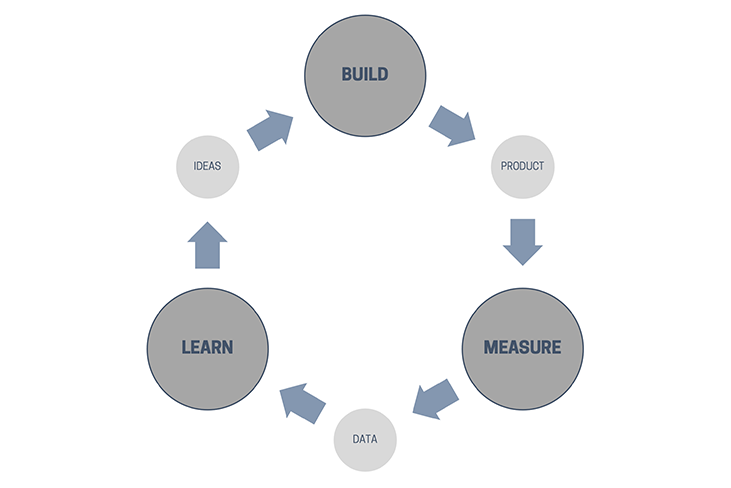The Lean Startup
The lean startup is a method for conceiving and executing a business initiative that emphasises experimentation and early feedback. Lean startup has become the dominant new business methodology in the technology sector and is rapidly gaining widespread adoption in other industries.

What it is
The lean startup is a methodology designed to promote productivity and development of products that directly meet the needs of a target customer segment while reducing wastage and initial capital outlay.
At a high level, the methodology is based on the concept of validated learning, which involves creating a Minimal Viable Product (MVP) and subsequent iterative releases, which are used to gather immediate feedback from product users based on hypotheses developed from feedback from previous releases. These iterations are based on the Build > Measure > Learn loop:

Once the initial MVP has been released, the Build > Measure > Learn loop will enable you to learn what your customers want next, develop your product based on their needs and systematically analyse progress with each successive iteration. This is the essence of lean startup thinking.
Background
The scientific method of developing and testing hypotheses was documented as early as the 2nd century AD by Egyptian mathematician and astronomer Claudius Ptolemy in his astronomical treatise, now known as the Almagest. In the 1930s, the Toyota Production System was developed, which popularized the concept of Lean Manufacturing.
In the mid-2000s Eric Ries and his colleague Steve Blank recognised that the main reason for failure within their company was a lack of customer engagement prior to product launch. As such, they began to question the traditional top-down approach to planning and product development. However, it wasn't until Ries formalised the approach and published his findings in his best-selling book The Lean Startup that the concepts began to be widely adopted.
When to use it
- When bringing new products to market.
- To systematically develop a product with minimal waste that meets the needs of target customers.
- When launching a successful startup business with minimal capital outlay.
How to use it
The lean startup is a set of strategies designed to help successfully develop and grow a startup as quickly and efficiently as possible, centred on continuous innovation and improvement. It is based on five core principles:
- Entrepreneurs are everywhere - whether it's within an established business or bootstrapping from a home office or garage, a startup is any institution formed for the purpose of creating new products or services under conditions of extreme uncertainty.
- Entrepreneurship is management - a startup is not the product itself but a complex system designed to operate under uncertainty. As such, startups require management systems geared towards this context.
- Validated learning - the building of a sustainable and efficient business can be best accomplished through experiments designed to test the vision.
- Build > Measure > Learn - this is the fundamental activity of the lean startup, facilitating fast, relevant and insightful feedback. Each iteration through the loop should be completed in the shortest possible time.
- Innovation accounting - traditional methods of measurement and accounting are not appropriate for the lean startup, so new ways must be implemented.
The Minimum Viable Product (MVP)
The MVP is a fundamental concept of lean startup thinking. Essentially, the idea is to find the cheapest and most straightforward way to gather feedback that will inform your learning. Often an early version of the product or feature, the MVP may well be incomplete and imperfect but reduces waste by gathering early feedback on ideas, rather than wasting time and effort pursuing a product design that customers do not find useful or valuable.
The strategies within the lean startup are formed into three broad categories - Vision, Steer and Accelerate:

Vision
Every new initiative requires a vision, whether within an established business or bootstrapping from a home office or garage. This vision acts as a 'north star' to guide product development decisions. Typically this vision is to create a product that targets an unmet need in the market or solves a problem or frustration identified by the entrepreneur or sponsor.
In order to validate the vision, non-traditional management systems are required to support the Build > Measure > Learn loop of experimentation and validated learning.
Steer
Startups must generate the answers to four key questions:
- Do consumers recognise they have the problem we are proposing to solve for them?
- Do they feel enough pain from the problem to buy our solution?
- Would they buy the solution from us?
- Can we build and continue to deliver that solution sustainably?
A successful startup focuses on iterating the Build > Measure > Learn loop as quickly as possible to answer those questions systematically.
Test
As with the scientific method, the lean startup approach works through experimentation to prove or disprove predictions or hypotheses. Each hypothesis must cover two distinct areas - value and growth.
The value hypothesis is intended to test whether the product or feature is valuable to customers. The growth hypothesis aims to test the ways customers find the product, to provide ideas for future development.
These hypotheses can be tested on an MVP, but if one is not yet available, other ways can be found to show the proposed product to users, such as prototypes, mockups, design or video walkthroughs.
This is the point at which the customer is brought into the development process - one of the fundamental ideas of the lean startup model. The MVP is presented to customers and feedback is sought to prove or disprove the hypotheses. This requires careful construction of the hypotheses to ensure that the result of the experiment is clear and actionable.
For a greater depth of feedback, a Concierge Minimum Viable Product approach can be adopted. In this instance, a small group of early adopters are personally visited and offered the product in exchange for instant feedback. Although this may seem wasteful, the ability to sit with customers, ask questions and note their needs means that the product development lifecycle can be vastly accelerated and more accurate.
Measure
Standard management accounting practices, such as forecasts and milestones, are unsuitable for fast-moving startups due to their unpredictability. Instead, the lean startup relies on "innovation accounting", which works in three stages:
- Establish the baseline - this is the learning gathered through user feedback of the initial MVP
- Tuning the engine - this achieved through incremental improvement of one or more drivers of a startup's growth model
- Pivot or persevere - over time, a decision must be made to continue on the present course or to pivot (change the business model) if the required growth is not evident.
Any metrics gathered should demonstrate the 3 A's:
Actionable - for a metric to be considered actionable, it should demonstrate clear cause and effect. If this is not the case, it is regarded as a vanity metric and should be discarded.
Accessible - all metrics should be simple and easily understood by all managers and employees who rely on them for decision-making purposes. Accessible metrics are clear, easy to reason about, well understood, comparable and unambiguous.
Auditable - the data must be credible to employees. When data is challenged, it must be possible to demonstrate how the metrics are derived from base data. Wherever possible, all metrics should be drawn from master data sets rather than secondary systems.
Accelerate
The Accelerate category is about learning - as quickly as possible - how to build a sustainable business. This is done through rapid experimentation and validated learning. To that end, the lean startup model recommends the following strategies:
Small batch sizes - this idea is taken directly from lean methodology and is about maximising value and minimising waste. Working on many small tasks from start to finish is more efficient than working on large batches of incomplete tasks.
Grow - growth is fundamental to building a sustainable business. Therefore, effort must be spent to acquire new customers through word of mouth advertising, funded advertising, repeat purchase or use, or as a side effect of product usage (through brand influence or via viral product design and marketing).
Adapt - mistakes and failures are inevitable, so the company must be able to learn from them by conducting root-cause analysis and adapting to knowledge gained as a result.
Innovate - as the company grows, it is crucial that management takes deliberate action to keep alive the spirit of innovation.
Related models

Further reading
Liker, J. K. (2021) The Toyota Way: 14 Management Principles from the World's Greatest Manufacturer, 2nd edition. New York: McGraw Hill.
Ries, E. (2011) The Lean Startup: How Constant Innovation Creates Radically Successful Businesses. London, UK: Penguin.
Some of the links to products provided in this article are affiliate links. This means that the supplier may pay the owner of this website a small amount of money for purchases made via the link. This will have absolutely no impact on the amount you pay.


